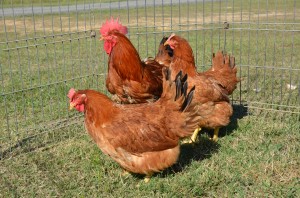Should I raise chickens?
Many people are drawn to the idea of raising backyard poultry for fresh eggs and the flavorful meat. Of course there are also other benefits as well, such as manure for fertilizing gardens, keeping down the populations of bugs and other garden pests and they are great companions.
But before you decide to join this fast growing trend, there are several things to consider when raising any poultry.
First , determine your time to dedicate to these animals and how they may impact your life and your family. They do require daily attention and chores. This means daily feeding, watering and yes cleaning up manure. Decide whether you want chickens for egg laying or meat production. If you want egg layers, keep in mind it usually takes 20+ weeks before you will see any eggs. If you want meat production, the best breed would be the Cornish Rock Broilers which take 6-8 weeks from start to finish. If you go with broilers we do recommend a strict feeding schedule of 12 hours on and 12 hours off.
Once you decide which breed of bird you are interested in, you next need to decide how much space you’ll need to accommodate the birds. If you live in a town or city you will also need to check your laws to determine how many you are allowed to have. Most cities have a limit of between 4-10 hens only. You do not need to have a rooster to have egg production. Do you have a coop for them or do you need to build one? A coop protects chickens from predators, and provides shelter from sun, cold and rain. It should have a locking door, a roosting bar and nesting boxes for layers. If you want to try to build your own, I would suggest a couple of items we sell at Welp Hatchery, the Multi-Purpose Mini Barn Plan or Poultry House Shelter Plan. If you’re not the DIY kind, there are numerous places on-line to order coops or check out your local farm supply store.
Before bringing your baby chicks home, you will want to be sure you have waterers, feeders, feed, bedding and a heating lamp. Your chicks need to be handled with care, so having everything set up before you bring them home will help alleviate any stress on the birds. You want to line your coop with woodshavings (not newspaper, it’s too slippery for the chicks), have clean fresh water and food, have the temperature set to 95 degrees for the first week. You drop the temperature 5 degrees every week until there is a constant temperature of 70 degrees or chicks are feathered out. Be sure that the chicks always have fresh water. This is very important as the chicks drink a lot of water.
Lastly, enjoy the chickens. They will provide an entertaining and relaxing atmosphere to your backyard, keep the bugs down, as well as provide you with eggs and or meat.
Contributed by Michelle Coleman


